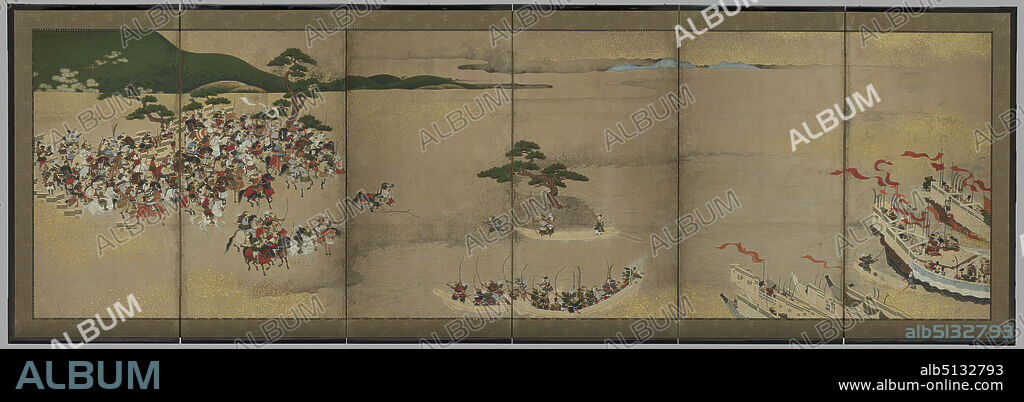alb5132793
Scene from the Battle of Yashima from the Tale of the Heike, late 17thearly 18th century, Six-panel folding screen: ink, color, and gold pigments and flakes on paper, unframed: 37 7/16 × 111 1/4 in. (95.1 × 282.6 cm), This screen panel depicts the penultimate battle during the Genpei Wars (118085), when Minamoto no Yoshitsune is saved by one of his retainers, Sato Tsugunobu, who had inserted himself between an enemy arrow and his master. The valiant retainer is shown plummeting off his horse at the center of the screen. One of the central themes of the painting is the samurai codeespecially the relationship between the lord and retainerdemonstrating the concerns and ideals of the military class at a time when betrayal was a real threat. When the screen was painted, however, the peaceful Edo life rendered such relationships irrelevant, weakening the shogunates control over its vassals. In the centuries before the Edo period, Zen Buddhism and the tea protocol emphasized the bond between teacher and student, rather than the bond between lord and retainer, making both practices popular among the samurai as well as the Buddhists. , Japan, Japanese, Edo period (16151868), Paintings.

|
Add to another lightbox |
|
Add to another lightbox |



Buy this image.
Select the use:

Caption:
Scene from the Battle of Yashima from the Tale of the Heike, late 17thearly 18th century, Six-panel folding screen: ink, color, and gold pigments and flakes on paper, unframed: 37 7/16 × 111 1/4 in. (95.1 × 282.6 cm), This screen panel depicts the penultimate battle during the Genpei Wars (118085), when Minamoto no Yoshitsune is saved by one of his retainers, Sato Tsugunobu, who had inserted himself between an enemy arrow and his master. The valiant retainer is shown plummeting off his horse at the center of the screen. One of the central themes of the painting is the samurai codeespecially the relationship between the lord and retainerdemonstrating the concerns and ideals of the military class at a time when betrayal was a real threat. When the screen was painted, however, the peaceful Edo life rendered such relationships irrelevant, weakening the shogunates control over its vassals. In the centuries before the Edo period, Zen Buddhism and the tea protocol emphasized the bond between teacher and student, rather than the bond between lord and retainer, making both practices popular among the samurai as well as the Buddhists. , Japan, Japanese, Edo period (16151868), Paintings
Credit:
Album / quintlox
Releases:
Model: No - Property: No
Rights questions?
Rights questions?
Image size:
4992 x 1703 px | 24.3 MB
Print size:
42.3 x 14.4 cm | 16.6 x 5.7 in (300 dpi)
Keywords:
118085 • 16151868 • AND GOLD PIGMENTS • ARMS: SAMURAI SWORD • BATTLE • BETRAYAL • BOND • CENTER • CENTRAL THEMES, THE • CENTURIES • COLOR • COLOUR • COMBAT • CONCERNS • DISPUTE • EDO PERIOD • EDO PERIOD • EDO-PERIOD • ENEMY ARROW • EQUUS CABALLUS • FAIRY TALES • FIGHT • FIGHTING • FLAKES • GENPEI WARS • HORSE • HORSES • IDEALS • INK • INSERTED • JAPAN • JAPAN-EDO PERIOD • JAPAN: SAMURAI • JAPANESE • LATE 17THEARLY 18TH CENTURY • LORD (NOBILITY) • LORD • MASTER. • MILITARY CLASS, THE • MINAMOTO NO YOSHITSUNE • PAINTED • PAINTING, THE • PAINTINGS • PAPER AND PACKAGE PRODUCTS • PAPER • PEACEFUL EDO LIFE RENDERED, THE • PENULTIMATE BATTLE • PRACTICES POPULAR • REAL THREAT. • RELATIONSHIP • RELATIONSHIPS IRRELEVANT • RETAINER • RETAINERDEMONSTRATING • RETAINERS • SAMURAI CODE • SAMURAI SWORD • SAMURAI WARRIOR • SAMURAI • SATO TSUGUNOBU • SAVED • SCENE • SCREEN PANEL DEPICTS • SCREEN • SCREEN., THE • SCUFFLE • SHOGUNATES CONTROL • SHOWN PLUMMETING OFF • SIX-PANEL FOLDING SCREEN • STRUGGLE • STUDENT • TALE • TEA PROTOCOL EMPHASIZED, THE • TEACHER • THE BUDDHISTS. • THE HEIKE • TIME • UNFRAMED • VALIANT RETAINER • VASSALS. • WEAKENING • WELL • YASHIMA • ZEN BUDDHISM
 Pinterest
Pinterest Twitter
Twitter Facebook
Facebook Copy link
Copy link Email
Email
